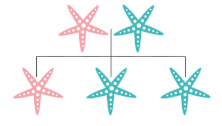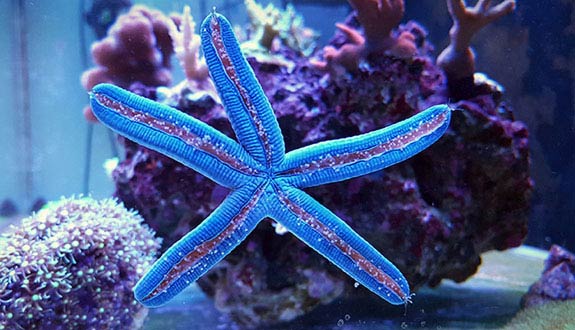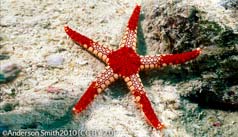

Alternative species (click on the thumbnail to see the card)
Names
Scientific name
Linckia laevigata, Linckia browni, Linckia crassae, Linckia hondurae Linckia miliaris, Linckia rosenbergi, Linckia suturalis, Linckia typus
Asterias laevigata
Ophidiaster clathratus, Ophidiaster crassa, Ophidiaster laevigatus, Ophidiaster miliaris, Ophidiaster propinquus
Common name
Blue sea star
Blue linckia
Origin

Origin: South Pacific and Indian Ocean, Red Sea
Natural habitat: up to 25m (82 feet) deep, on hard bottoms (not sandy)
Dimorphism

none
Group

Ophidiasteridae
Volume

300 L / 66 Imp Gal / 79 US Gal
Parameters

T°: 25°C or 77°F
pH: 7.5 to 8.5
Density: 1021 to 1024
Difficulty

Average
Size

20 to 30cm (7.9 to 12")
Longevity

5 years and more
Living zone

Everywhere
Individuals

1
Food
How to feed the Blue sea star?
Food
How to feed the Blue sea star?
Most of their food consists of the biofilm that covers the scenery and rocks. Starfish are also detritus feeders. For example, they feed on the leftovers from the meals of other aquarium inhabitants. In this respect, they are an excellent aid to aquarium maintenance.
It is imperative to supplement their diet. Offer them traditional fish pellets to place nearby and make sure that no other inhabitants eat their food!
Behavior
What kind of behavior does the Palette Blue sea star have?
Behavior
What kind of behavior does the Blue sea star have?
Social and peaceful, it does not show any aggressiveness.
It moves on hard surfaces and does not like sand. Its activity is rather nocturnal. During the day, it hides in the crevices of the scenery.
Cohabitation
Who can live with the Blue sea star?
Cohabitation
Who can live with the Blue sea star?
This inveterate is a lonely man. Therefore, you will only introduce one specimen per aquarium, regardless of its size.
Beware of maintenance with certain corals that this starfish can damage. Indeed, depending on the configuration of its place of capture, some individuals keep the annoying tendency to nibble corals.
Of course, avoid cohabitation with predatory fish such as Apolemichthys.
Breeding
How to breed the Blue sea star?
Breeding
How to breed the Blue sea star?
Sexual breeding of this species is very rare in aquariums. Note that young starfish are blue with black dots.
Its aquarium
Which aquarium for the Blue sea star?
Its aquarium
Which aquarium for the Blue sea star?
A reef aquarium with rocks, corals and anemones can be suitable for the proper maintenance of this species, and by extension it is suitable for all marine aquariums. Beware of maintenance with some corals that this starfish can damage. Indeed, according to the configuration of its place of capture, some individuals keep the annoying tendency to nibble corals.
In order for it to find food in your aquarium, the aquarium must be well established, stable and mature enough to provide the starfish with sufficient biofilm. This is why a 300 L / 66 Imp Gal / 79 US Gal aquarium is a minimum, so that the microfilm surface is sufficient.
This species is quite sensitive to variations in water parameters.
It does not like too bright light and will come out easier under moderate lighting.
Good To know
Find all additional information!
Good To know
Find all additional information!
Did you know that the Linckia laevigata is the only entirely blue starfish?
This starfish has more than one trick up its sleeve! In some cases, thanks to its very impressive regenerative properties, a new individual can be born from a severed arm! On the other hand, in the home aquarium, this operation is very risky.
In most cases, this starfish has five arms. But some specimens develop a sixth!
In the wild, it lives in symbiosis with the asteroid shrimp (starfish shrimp or seastar shrimp in Aglais) (Periclimenes soror) which measures only 1.5 cm (0.4"). The latter becomes blue to blend completely with Linckia laevigata (it can also be beige, red, yellow...). The shrimp finds its food near the starfish's mouth, while the starfish takes advantage of this care and cleaning that it could not do alone.
Like all invertebrates, the Linckia is very sensitive to copper, which is toxic for it. Be very careful if you have to administer medical treatments based on medication!
Never take your starfish out of the water! It can swallow air, which will be fatal.
Generally, this starfish is blue, but its colour can vary from pale blue to light brown to purple.
Yours photos!
Comments
Sort by:
Please login to post comments


